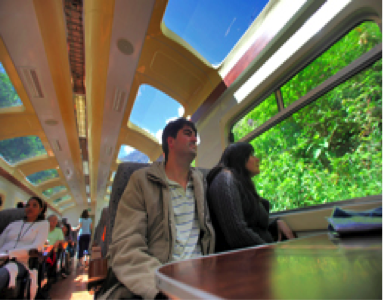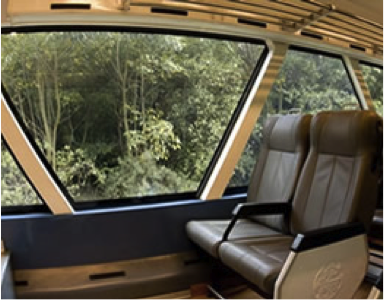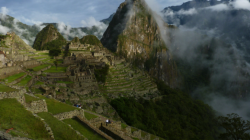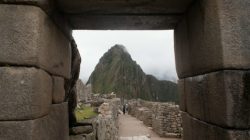Check out Part I: Advance Preparation
There are only two ways to get to Machu Picchu: by foot or by train. If you have the time, money and inclination to do so, traveling to the ruins by foot sounds like an incredible experience. Most accomplish this through a guided four-day trek along the Inca Trail, an ancient paved route that connects Machu Picchu to the Incan (and current regional) capital of Cuzco. Note that taking a guide for this trek is mandatory according to Peruvian law.
In addition to what you will find in your guidebook, there is a lot of information available on the internet for those interested in this hike. You will find two fairly comprehensive sources here and here. There are a number of alternative, lesser-used trekking routes to Machu Picchu and some of these can be done fairly inexpensively, although the time commitment is still substantial. Here is an example itinerary, offered by a hostel in the region.
Most travelers, myself included, opt for the train-and-bus route to Machu Picchu. This route is faster, more flexible, and cheaper than traveling by foot, although the trains are by no means inexpensive. Three companies offer train service to Machu Picchu from Ollantaytambo to Aguas Calientes (Machu Picchu): Peru Rail, Inca Rail, and Machu Picchu Train. Of these companies, only Peru Rail offers service from Urubamba and Cuzco. This company also offers the most flexible schedule.
Whichever service you choose, expect costs ranging from $50-80 one-way for any of the standard routes (a one-way trip on the luxury Hiram Bingham route costs more than $300). Many, if not most, travelers and tour groups opt for a one-day tour of Machu Picchu with round-trip train service from Cuzco. My opinion is that this is a bad idea, for the following reasons:
- Most travelers opt for the one-day round-trip tour of Machu Picchu. This means that you will be sharing the ruins, including its vistas and narrow walkways, with all the visitors that Machu Picchu can accommodate. This also means that you will be paying slightly inflated prices for train fares.
- Machu Picchu opens at 6 AM. However, the earliest times that you can arrive in a one-day visit are 8 AM (from the Sacred Valley) or 10 AM (from Cuzco). That doesn’t just mean that you miss the morning golden hour. It also means that you will be arriving at Machu Picchu when the temperature is roughly 10 degrees (Fahrenheit) hotter and the sun is much more intense.
- Between the train and the bus, you will be committing to at least four hours of transit in the day that you tour Machu Picchu, assuming that you are staying in Ollantaytambo and are comfortable with leaving no grace period before train departures. Realistically, a day trip from Cuzco to the ruins will include over eight hours of transit for roughly four hours of touring.
Keep in mind that the Cuzco train station is not located in the town of Cuzco, but rather in the neighboring district of Poroy, which is roughly twenty minutes outside of town by taxi. If you decide to depart from Ollantaytambo, the fastest taxi route is closer to ninety minutes. We decided to opt for this route because Peru Rail offers afternoon departures from Ollantaytambo, a service that does not exist in Poroy.
For us, the cost of a taxi from Cuzco to Ollantaytambo was quoted at 100 soles (roughly $40 USD), and for an extra 100 soles we were able to make stops at the ruins in Chinchero and Moray (this trip took slightly longer than four hours). Whatever route you choose, I recommend that you have your hotel arrange taxis for you.
Once you arrive by train, you will need to take a bus from the town of Aguas Calientes to Machu Picchu. At the time of this writing, round-trip service on the bus costs $17 USD and is slightly cheaper if you pay in Peruvian soles. Buses depart throughout the days, and are very frequent (every ten minutes or so) during peak hours. From the train station, the bus stop is not far. On this map from the Moon Guide, the bus stop is located across the river from Toto’s House.
If you follow my advice and seek alternatives to Machu Picchu day trips, you will need to spend at least one night in Aguas Calientes. Before addressing the town and the services that you can find, I would like to make one final note on the trains themselves. Look at the following two pictures from the Peru Rail website:
The picture on the left is from Peru Rail’s budget “Expedition” service, whereas the one on the right represents their slightly higher-end “Autowagon” trains. Not much difference, right? From the pictures alone, that would appear to be the case. Based on the roof windows in the Expedition train, you might assume that the cheaper train could even be better. However, the difference between the expedition and first-class services is actually striking.
As the picture indicates, the Autowagon trains have roof racks (and appear to be the only Peru Rail trains that have this). This is a major consideration for travelers who intend to overnight in Aguas Calientes. On the Expedition trains, you have to leave your luggage on racks near the end of the carriage. This represents a security risk, especially if you are seated facing away from the luggage rack.
Another, less obvious difference between the two trains is that they are arranged in different seating formats. The Autowagon trains feature the conventional 2-2 seating arrangement, with all seats facing the same direction. On the other hand, nearly all seats on the Expedition trains have a 4-4 configuration.
As a reasonably tall person who values legroom, I despise the 4-4 configuration. This arrangement obliges you to compete for legroom with the people sitting across from you. And in the case of the Expedition trains, there is very little legroom to compete for. If you are uncomfortable with leaving your luggage on the rack at the end of the train, you have no choice but to surrender even more of your legroom. Making matters worse, the budget trains, which have multiple carriages, jostle a lot more than their higher-end counterparts.
Overall, the Expedition trains are significantly less comfortable. Therefore, the premium for the better service is entirely worth paying for. It is worth mentioning that the snack and beverage service is much better in the higher-class trains as well. I should also add that the Vistadome trains may be arranged in either the 2-2 or 4-4 configuration, judging from pictures available online. I cannot speak with certainty about the quality of these trains; one of our bookings was for “Vistadome” service, but the placard on the front of the train clearly indicated that we were on an “Autowagon”. Perhaps someone else can set the record straight on this.
AGUAS CALIENTES
If you follow my advice (and I think you should), you should spend a night or two in Aguas Calientes. If you do this, you should prepare accordingly. Here are some descriptions of the town that the Peruvian government calls Machu Picchu Pueblo: “a small and humid, ramshackle tourist trade village”, “one of the ugliest, most exploitative towns you’ll run across anywhere in Peru”, “compared to the rest of the country… Aguas Calientes is exorbitantly expensive.” While the second statement is probably hyperbole, the gist of these arguments is essentially true.
Aguas Calientes is little more than a tourist trap, with little culture and plenty of exploitation. Therefore, I strongly recommend that you research this place well, using frequently updated resources like Tripadvisor because conditions change quickly. Generally speaking, expect to pay at least double for food and even more for accommodations in Aguas Calientes as compared to Cuzco.
Aguas Calientes is a small town, as this map clearly indicates. The town is built in the valley below Machu Picchu and is surrounded by beautiful cloud forest and mountains. In fact, this natural beauty is one of the most appealing aspects of staying here. If you are not planning to visit the Amazon headwaters, this will probably be your only exposure to cloud forest in Peru. Much of the town is built up along the banks of the Rio Aguas Calientes, which runs into the Urubamba to the west and separates the train station from most of the town’s hotels and restaurants.
Speaking of those hotels and restaurants, many of them are terrible. I strongly encourage using Tripadvisor to identify them, because chances are good that your guidebook will not do a great job of keeping up. Beyond that, some common sense goes a long way. Many of the restaurants in town employ touts to cajole tourists into eating at their establishments. These restaurants are typically the worst ones. While annoying, Aguas Calientes’ touts are not particularly aggressive; following Nancy Reagan’s advice does wonders.
As for hotels, prepare to make some sacrifices. We were fortunate enough to have a clean room, consistently hot water, and limited internet service at this hotel, while putting up with ridiculously thin walls and poor ventilation. Deals are nearly impossible to find here, but your mileage may vary. One thing to take advantage of is the fact that many hotels will hold your luggage for you, which is a huge consideration if you plan to return to Ollantaytambo or Cuzco after visiting Machu Picchu, as we did.
If you decide to spend even more time here, there are things to do in Aguas Calientes that do not involve the bus trip to Machu Picchu. Here is a quick listing of the most popular activities: climbing the sacred mountain of Putucusi (the ladders scaling the mountain washed out in a flood but were recently replaced at the time of this writing), visiting the Machu Picchu Museum, bathing in the questionable hot springs from which the town derives its name.
If you arrive a day early and have time to do this, I recommend getting your bus passes and return train ticket sorted out. Taking care of these things early will save you a lot of time and a fair amount of grief. Another thing you can do is arrange to have a box lunch prepared for your trip to Machu Picchu. We had ours made at a restaurant and the food was pretty good, although expensive at over 30 soles ($12 US). Keep in mind that if you are unable to arrange a box lunch, you can buy food at the ruins themselves. The quality will be somewhat worse, but the price won’t be noticeably higher.
NEXT UP (in a few days): Visiting the ruins of Machu Picchu.






